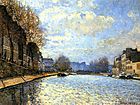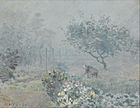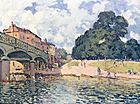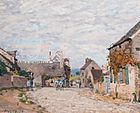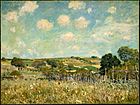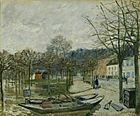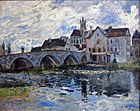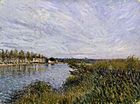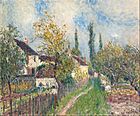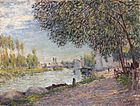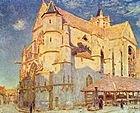Alfred Sisley facts for kids
Quick facts for kids
Alfred Sisley
|
|
|---|---|
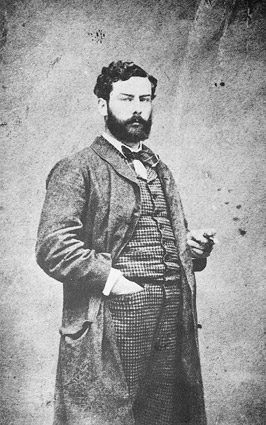
Sisley in March 1863
|
|
| Born | 30 October 1839 Paris, France
|
| Died | 29 January 1899 (aged 59) Moret-sur-Loing, France
|
| Nationality | British |
| Education | Marc-Charles-Gabriel Gleyre |
| Known for | Painting |
| Movement | Impressionism |
Alfred Sisley (born October 30, 1839 – died January 29, 1899) was an Impressionist landscape painter. He was born in Paris, France, and lived most of his life there, but he was a British citizen. Sisley was known for painting outdoors, a style called en plein air. He focused mostly on landscapes and rarely painted people. Unlike some other Impressionists, he felt that this style was perfect for his art.
Some of his most famous paintings show the River Thames in England, especially around Hampton Court Palace. He also painted many landscapes near Moret-sur-Loing in France. His paintings often show calm scenes with soft colors like green, pink, purple, blue, and cream. Over time, his use of color and his way of showing feelings in his art became even stronger.
Biography
Alfred Sisley was born in Paris to wealthy British parents. His father, William Sisley, worked in the silk business. His mother, Felicia Sell, loved music and culture.
In 1857, when he was 18, Alfred was sent to London to study business. But after four years, he decided he wanted to be an artist instead. He returned to Paris in 1861. In 1862, he started studying art at the Paris École des Beaux-Arts. There, he met other young artists like Frédéric Bazille, Claude Monet, and Pierre-Auguste Renoir.
These artists loved to paint landscapes outdoors, not in a studio. This way, they could capture how sunlight changed the scene. This was a new idea at the time. Their paintings were much more colorful and freely painted than what people were used to seeing. Because of this, Sisley and his friends found it hard to show or sell their art at first. Their paintings were often rejected by the important annual art show in France, called the Salon. In the 1860s, Sisley was better off financially than his friends because his father gave him money.
In 1866, Sisley started a family with Eugénie Lescouezec (also known as Marie Lescouezec). They had two children, a son named Pierre (born 1867) and a daughter named Jeanne (born 1869). At this time, Sisley lived near a popular meeting place for Parisian painters, the Café Guerbois.
In 1868, some of his paintings were accepted at the Salon. However, this did not bring him much money or fame. His later exhibitions also did not bring him success.
In 1870, the Franco-Prussian War began. Because of the war, Sisley's father's business failed. From then on, Sisley had to rely on selling his paintings to support himself. He lived in poverty for the rest of his life, as his paintings did not become very valuable until after he died. Sometimes, people who supported artists would help him. This allowed him to take a few short trips to Britain.
His first trip to Britain was in 1874, after the first Impressionist art show. He spent a few months near London and painted almost twenty pictures of the River Thames. An art expert later called these paintings "a perfect moment of Impressionism."
Until 1880, Sisley lived and worked in the countryside west of Paris. Then, he and his family moved to a small village near Moret-sur-Loing. This area was close to the forest of Fontainebleau, where other famous painters had worked before. An art historian said that the calm landscapes and changing weather there were perfect for his artistic style. Unlike Monet, Sisley did not paint dramatic oceans or bright, colorful scenes.
In 1881, Sisley made another short trip to Great Britain.
In 1897, Sisley and his partner visited Britain again. They finally got married in Wales on August 5. They stayed in Penarth, where Sisley painted at least six oil paintings of the sea and cliffs. Later in August, they moved to Langland Bay on the Gower Peninsula. There, he painted at least eleven oil paintings of the area. They returned to France in October. This was Sisley's last trip to his home country. The National Museum Cardiff has two of his paintings from Penarth and Langland.
The next year, Sisley tried to become a French citizen, but he was not allowed. He tried again, but he became ill. Sisley remained a British citizen until he died.
He died on January 29, 1899, from throat cancer in Moret-sur-Loing. He was 59 years old. This was a few months after his wife had passed away. He was buried with his wife in the Moret-sur-Loing Cemetery.
Work
We don't have Sisley's early student paintings. His first landscape paintings were dark, using browns, greens, and pale blues. He often painted them in places like Marly and Saint-Cloud. We don't know much about how other artists like J. M. W. Turner and John Constable influenced him, but some people think they might have helped him develop his Impressionist style. Artists like Gustave Courbet and Jean-Baptiste-Camille Corot might have also influenced him.
Sisley was inspired by the style of earlier modern painters like Camille Pissarro and Edouard Manet. Among the Impressionists, Sisley is sometimes less known than Monet. Their styles are similar, but Sisley's paintings are often calmer. One art expert said his work often feels like a perfect example of an Impressionist painting. His art really captures the feeling of the air and weather, and his skies are always beautiful. He focused on painting landscapes more than any other Impressionist painter.
Some of Sisley's most famous works include Street in Moret and Sand Heaps, which are at the Art Institute of Chicago. The Bridge at Moret-sur-Loing is at the Musée d'Orsay in Paris. His painting Allée des peupliers de Moret (The Lane of Poplars at Moret) has been stolen three times from the Musée des Beaux-Arts in Nice.
Sisley created about 900 oil paintings, around 100 pastels, and many other drawings.
Selected works
- Avenue of Chestnut Trees near La Celle-Saint-Cloud (1865)
- View of Montmartre from Cité des Fleurs to Les Batignolles (1869)
- The Bridge at Villeneuve-la-Garenne (1872)
- Ferry to the Ile-de-la-Loge – Flood (1872)
- La Grande-Rue, Argenteuil (c. 1872)
- Square in Argenteuil (Rue de la Chaussee) (1872)
- Footbridge at Argenteuil (1872)
- Chemin de la Machine, Louveciennes (1873)
- Louveciennes. Sentier de la Mi-côte (1873)
- Hampton Court Bridge (painting) (1874)
- Molesey Weir – Morning (1874)
- Regatta at Molesey (1874)
- Under Hampton Court Bridge (1874)
- The Terrace at Saint-Germain, Spring (1875)
- The Small Meadows in Spring, By (c. 1881)
Images for kids
-
Pierre-Auguste Renoir, Alfred Sisley and his Wife, 1868
-
Molesey Weir – Morning, painted by Sisley in Britain in 1874
-
Resting by a Stream at the Edge of the Wood, 1878, Musée d'Orsay
-
La Seine au point du jour, 1877, Musée Malraux, Le Havre
Gallery
-
La Petite Place - La Rue du Village (1874), Aberdeen Art Gallery
-
The Flood at Port Marly (1876), Fitzwilliam Museum
-
Le Pont de Moret, effet d'orage, 1887, Musée Malraux, Le Havre
-
View of Saint-Mammès, (circa 1880), The Walters Art Museum
-
Le Givre à Veneux, 1880, University of Michigan Museum of Art
See also
 In Spanish: Alfred Sisley para niños
In Spanish: Alfred Sisley para niños







